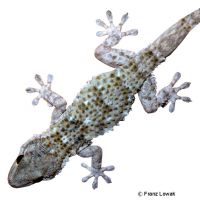Common Wall Gecko (Tarentola mauritanica)
| Common Wall Gecko Tarentola mauritanica | |
|---|---|
| Name | Common Wall Gecko |
| Name Lat. | Tarentola mauritanica |
| Family | Leaf-toed Geckos |
| Family lat. | Phyllodactylidae |
| Order | Scaled Reptiles |
| Order lat. | Squamata |
| Origin | Africa |
| Habitat | Dry savanna |
| Diet | Insects |
| Humidity | 30-50 % |
| Behavior | ♂ territorial |
| Keeping | Individual, pair, harem |
| Care Level | Easy |
| Reproduction | Oviparous |
| Housing | Dry terrarium |
| Life Span | 8 years |
| Protection | No |
| Metric Units | |
| Size | 13 cm |
| Temperature | 26-32 °C |
| Temperature Local | 40 °C |
| Housing Size | 60 x 60 x 80 cm |
| US Units | |
| Size | 5" |
| Temperature | 79-90 °F |
| Temperature Local | 104 °F |
| Housing Size | 25" x 25" x 30" |
Distribution and habitat
The distribution range of the mainly crepuscular to nocturnal North African Wall Geckos extends from North Africa and Southeastern Europe to Southwest Asia. There, the good climbers live hidden in rock crevices and as cultural successors on walls and house walls.
Maintenance
Minimum dimensions for the terrarium, according to the size and number of animals
| 1-2 animals | 6KRL x 6KRL x 8KRL (L x W x H) |
Head-torso length (KRL) is measured on the largest animal. For each additional animal, increase the footprint by 15%. A terrarium of e.g. 60 x 60 x 80 cm is recommended, which should be placed in a quiet and vibration-free place.
You will need a terrarium with roots and stone structures that provide numerous hiding and shade places, structured back and side walls (e.g. cork lining), a substrate of sand-clay mixture and a small water container, as well as hardy, drought-resistant, potted plants (e.g. succulents). A small portion of the substrate, especially the lower sand layers, should always be kept slightly moist. Once a day, preferably in the evening, the terrarium furnishings should be finely sprayed with water, but not directly the animals. At night, increase the humidity to about 70%. A rain or misting system is ideal.
| Temp. day: 26-32 °C | Temp. night: 18-22 °C | Temp. local: up to 40 °C | Humidity: 30-50 |
Thermostatically controlled floor heating is recommended. Lighting duration must be 12-14 hrs. Daylight fluorescent tubes are ideal. A special UV light is not necessary.
Diet
The food supply consists of live insects according to their size, such as crickets, house crickets, grasshoppers, cockroaches, zophobas and mealybug larvae. Alternatively, special ready-made food for insectivorous reptiles can be offered, possibly with tweezers for habituation. Wax moths should only be fed in small amounts to adults, but not to juveniles, because of their large fat content. Regular addition of minerals and vitamins (dusting of food) is important. Young animals should be offered food daily, adult animals 4-5 times a week. Drinking water must always be available. A regular and varied diet promotes health and prevents deficiency symptoms.
Reproduction and breeding
The adult male has a thickened caudal root with a distinct hemipenis pouch.
The female lays her eggs (1-2 pieces) hidden in the decoration several times a year. The incubation period depends on the temperature and is 90-120 days at a temperature of 26-30 °C. Small insects such as fruit flies and micro crickets are suitable as initial food for the young
Species protection
The animal population must be reported to the competent authority in writing immediately after the start of keeping. Your pet store will be happy to provide you with further information.
Species protection: Federal Species Protection Ordinance (BArtSchV). The proof of purchase is the required proof of origin for the animal. Please keep it safe!
Important
They have a single row of broad adhesive lamellae on their toes spread to the tip.
Adult males behave territorially. They can be well maintained in a small group, one male with 2-3 females.
They require basking sites with radiant heat, such as rocks irradiated with a spotlight. For the resting phase, shorten the lighting time by 2-3 hours and lower the temperature by 4-6 °C for about two months.
With fruit and honey water as food for the feeders, their quality can be upgraded.
The terrarium must have good ventilation without drafts and meet the species specific needs. Measuring devices such as thermometers, hygrometers, etc. are necessary. The lighting has to correspond to the species-specific day-night rhythm and has to be placed in such a way that the animals cannot injure themselves. The terrarium should be locked in such a way that neither unauthorized persons can open it nor the animals can escape. Contamination must be removed regularly.
Further literature can be found in your pet store.
References
Text: Christian Sänger; Image: Franz Lowak
Source: BMELV (1997): Tierschutzgutachten - Mindestanforderungen an die Haltung von Reptilien; ENGELMANN (2006): Zootierhaltung - Tiere in menschlicher Obhut: Reptilien und Amphibien, Harri Deutsch Verlag
- Gemäß § 21 Abs. 5 Tierschutzgesetz idgF
